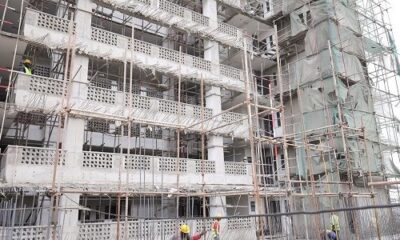A lot of people have complained about the heat which is pervading all parts of Kenya, but extremely so in urban areas. This heat is too much! Who did we offend! Go the complaints on social media. Well, environmental destruction is to blame — as well as climate change — but have you heard of the urban heat island effect?
An urban heat island effect is basically what it sounds like, an urban area which is far hotter than the surrounding rural areas. Sort of like the central part of hell, where the ovens are located.
Like many other cities, Nairobi is made up of a heavily built environment, that is, a man-made environment where nature has been to a large part altered and entirely removed. Tall skyscrapers, tarmacked roads, pavements and dull looking buildings make up most of the city. Green spaces which are rare and almost non-existent are rapidly disappearing in the city. It is indeed the famed concrete jungle.
To add to that, now more than ever we seem determined to continue ‘developing’ the city with more and more real estate firms and companies building homes and workspaces to cater for the increasing human population. But, as is characteristic of mankind, we think our plans are best, better than nature itself, and we seek to alter any space we are in, unfortunately without any thought of the consequences.
To get back to the point, cities and towns are hotter than surrounding rural areas because tarmac and concrete absorb and retain heat at a level thousands of times more than normal ground surfaces. Similarly, skyscrapers, commonly made of glass which is good for aesthetic purposes, not only reflect heat and light to each other, they also block the easy movement of wind by virtue of their height.
Pollutants such as ground level ozone and carbon dioxide produced by vehicles, of which there are tens of thousands in Nairobi at any given moment, absorb all ambient heat and further magnify the heat imprint in the city. Both ground level ozone and carbon dioxide are greenhouse gases and, characteristic of their properties, do not release heat easily. This is one of the causes of climate change whose consequences are already with us.
To add to all this, we continue cutting down trees and encroaching on natural green spaces bordering the city, such as Karura, Oloolua and Ngong forests as well as the Nairobi National Park. Trees and all greenery are not a part of nature by accident. Not only do trees respire for us, that is they “breathe” for us, absorbing carbon dioxide and releasing oxygen, I’m sure we all remember photosynthesis from high school, they also reduce heat, by a process called evapotranspiration. They give up moisture from their leaves in the process taking up heat.
Incidentally, if there are huge amounts of trees in an area, that is, a forest, massive amounts of water are transpired up to the air and this later forms clouds which come down as rains and bathe the overbearing heat away.
This is what the phrase, forests attract rain means.
Trees are also a life saver because truly, what compares to good shade and fresh air on a hot day? Now in a city such as Nairobi where air pollution not only worsens heat problems, human health is also majorly affected as pollutants, such as lead released from vehicle exhaust, are concentrated at ground level. The human body is not designed to cope with extreme heat thus making one uncomfortable. It also predisposes one to heat stress and migraines.
The skin is also affected by the hot sun and one is advised to wear sunscreen, a hat (wide brimmed one), wear light clothing, try keeping hydrated and out of the sun’s direct path.
Such a high level of heat demands cooling and as such the water demand is amplified, and cannot be adequately met by the already stressed water supply.
As urban heat islands, cities generally consume more power as people use air conditioning to try and cool themselves.
Now, in the midst of all this, it is important to note that there are ways we can try and change the equation. Instead of skyscrapers being made of glass and concrete, it is recommended to use eco-friendly materials, which are breathable. Try rooftop gardens instead of concrete tops, better still integrate it with rooftop solar as a way of generating renewable energy.
Also, buildings should be constructed in a way that allows natural lighting and cooling. In this way we consume less power and reduce the carbon footprint.
It might also be prudent not to cut down any trees. Plant more of them instead. Nobel Peace Prize Laureate and renown environmentalist Wangari Maathai was ardent about this. Trees are the lungs of this planet and in our greed to harvest them for timber, wood and fuel, we are actually destroying the planet, and ourselves.
It would be great that every time we construct a building or office park, we incorporate real actual greenery.
Take care of the environment. Plant more trees. Conserve energy. Stop wasting water. Avoid buying products from forests. Buy recycled products. Be environmentally conscious.

 General News3 days ago
General News3 days ago
 General News3 days ago
General News3 days ago
 General News3 days ago
General News3 days ago
 General News2 days ago
General News2 days ago
 General News16 hours ago
General News16 hours ago
